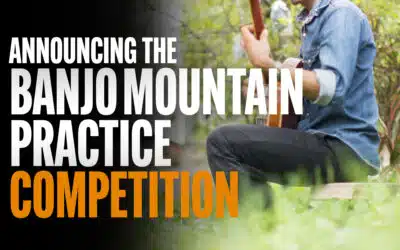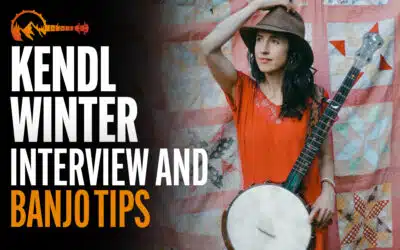In my years teaching clawhammer banjo, I’ve found that once students have mastered some of the more basic mechanics (i.e. bum-ditty, pull-offs, slides, hammer-ons, simple chords, drop-thumb, rhythm fundamentals), things generally go smoothly up to a point – that is, until another subtle yet slightly more complex left-hand maneuver is introduced: the alternate-string/left-hand pluck. True, this technique may be a little trickier than other fretting-hand techniques you’ve learned up to this point, but if you practice it consistently and deliberately you’ll be amazed at the array of melodic possibilities suddenly available to you. (Side note: if you’re unfamiliar with the term “deliberate practice”, please read our article on this important topic.)
It’s Not A Pull-Off
Before we jump into the mechanics of this particular maneuver, let’s get one thing straight: the alternate-string/left hand pluck is NOT a pull-off. True, both maneuvers involve plucking a string with the fretting hand. But a pull-off involves only one string – the right hand picks a fretted string, which is then plucked/pulled/yanked by the finger fretting this note. With an alternate-string pull-off, after the right hand picks a string, the fretting-hand finger plucks/pulls/yanks a completely different string. The advantage to this maneuver is that it enables the picker to play notes that would otherwise be difficult or impossible for the picking hand to handle alone. In doing so, it opens the door for more complex rhythms and melodies. Pretty cool.
The Great Ken Perlman’s Opinion
Clawhammer master Ken Perlman (check out his incredible skills here) describes the alternate-string/left-hand pluck as an “anticipation technique” – that is, the fretting-hand finger executing this maneuver must be set in plucking position at the moment the preceding string is plucked by the right hand. Specifically, the fretting-hand finger needs to make CONTACT with the string it intends to pluck at the precise moment the preceding string is plucked by the right hand. If the fretting-hand finger executes this maneuver AFTER the right hand has plucked the previous string, an inadvertent “thwack!” or hammer-on will usually be heard.
Intricacies Of The Skill
Keep in mind that even though the fretting-hand finger makes contact with a string, it should NOT make contact with the fretboard. If the fretting-hand finger applies even the slightest amount of pressure to the fretboard as it readies itself for this maneuver, you’ll hear the overtones of an additional, unwanted note. There are varying opinions among pickers as to how much pressure to apply to the fretboard when performing this maneuver. I’m of the school of thought that if the alternate string being plucked is an OPEN string, the finger plucking it should not make any contact whatsoever with the fretboard. If, on the other hand, the alternate string being plucked is fretted, it’s best to apply as little pressure as possible to to the fretting-hand finger when executing this maneuver (I find it’s close to impossible to avoid contact with the fretboard when the alternate string being plucked is a fretted string).
Tablature, unfortunately, will never explicitly tell you which finger to use when executing this maneuver. The best indicator for this will be the context in which the maneuver appears. If you’re conversant in banjo tab, you should be able deduce fairly easily which finger will work best in executing a successful alternate-string pluck in any given scenario.
Practice, Practice, Practice
This technique will take some time getting used to, so if you’re completely new to it my advice would be to watch the Banjo Mountain lesson that covers this maneuver. Then drill it it consistently and deliberately for the next week until you’re able to perform it cleanly, evenly and confidently…And then, if you’re feeling really adventurous, check out a few songs on this website that employ this ultra-cool technique! Here is the “Left Hand Pluck/Alternate-String Pluck” lesson offered in our Clawhammer School (your’s for free!):
Check out the “chapter” markers just to the right of the “sprocket” in the playbar.
FULL ACCESS TO 200+ LESSONS
3 GREAT OPTIONS FOR YOU

Annual Subscription
SAVE OVER 70%Full access to Banjo Mountain (200+ lessons) for $139.95 saving you over 70%.
Bills annually. Cancel anytime.
3-Month Subscription
Full access to Banjo Mountain (200+ lessons) for $75 saving you over 35%.
Bills every 3 months. Cancel anytime.
1-Month Subscription
Full access to Banjo Mountain (200+ lessons) for $40.
Bills monthly. Cancel anytime.
STILL NOT SURE?
Latest From Our Blog
Nora Brown: A Rising Star In The Banjo World
Nora Brown is someone to keep your eye on. Indeed, at a young age, she is already turning heads. Hailing out of Brooklyn, New York, Nora has played festivals all over the country. Don’t let Brooklyn throw you off (no offense Brooklyn-ites). While having urban origins,...
The 1st Banjo Mountain Practice Competition
We are pleased to announce the first Banjo Mountain Practice Competition. This is for Banjo Mountain students. It costs nothing to enter and you can do so once you have subscribed. The goal here is to encourage daily practice by submitting your video for your peers to...
Kendl Winter Interview & Banjo Tips
Video interview with Kendl Winter where she shares tips and advice for banjo players, talks about how she got into banjo, what projects she's currently working on and her upcoming album "Banjo Mantras." Her single "Humming Mantra" will be live September 8th! A...



